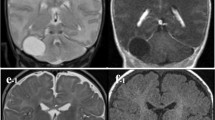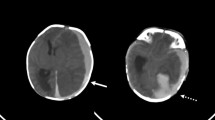Summary
Descending tentorial herniation (DTH) can be diagnosed by computed tomography. Encroachment upon the lateral aspect of the suprasellar cistern is an early sign of impending tentorial herniation. Actual herniation is evidenced by rotation and shift of the brain stem with consequent widening of the crural and ambient cisterns on the side of the space-occupying lesion. In a more advanced stage of herniation, obliteration of cisternal spaces at the tentorial level will occur. Aqueductal compression secondary to the herniation will cause increased intraventricular pressure with widening of those parts of the lateral ventricles that are not exposed parts of the lateral ventricles that are not exposed to the compression by the mass; a characteristic finding is widening of the temporal horn on the side opposite the space-occupying lesion. Infarction in the territory of the posterior cerebral artery may complicate DTH.
Similar content being viewed by others
References
Meyer, A.: Herniation of the brain. Arch. Neurol. Psychiatry 4, 387–400 (1920)
Lindenberg, R.: Compression of brain arteries as pathogenetic factor for tissue necroses and their areas of predilection. J. Neuropathol. Exp. Neurol. 14, 223–243 (1955)
Sunderland, S.: The tentorial notch and complications produced by herniation of the brain through that aperture. Br. J. Surg. 45, 422–438 (1958)
Mastri, A.R.: Brain herniations: I. Pathology. (In) Radiology of the Skull and Brain, vol. 2, book 4, pp. 2659–2670. Ed. by Newton, T.H., Potts, D.G. St. Louis: Mosby 1974
Azambuja, N., Lindgren, E., Sjogren, S.E.: Tentorial herniations: II. Pneumography. Acta Radiol. 46, 224–231 (1956)
Liliequist, B.: Encephalographic changes in the axial pressure cone syndrome. Acta Radiol. 54, 369–378 (1960)
Perret, L.V., Margolis, M.T.: Brain herniations: II. Angiography. (In) Radiology of the Skull and Brain, vol. 2, book 4, pp. 2671–2699 Ed. by Newton, T.H., Potts, D.G. St. Louis: Mosby 1974
Naidich, T.P., Pinto, R.S., Kushner, M.J., Lin, J.P., Kricheff, I.I., Leeds, N.E., Chase, N.E.: Evaluation of sellar and parasellar masses by computed tomography. Radiology 120, 91–99 (1976)
Osborn, A.G.: Diagnosis of descending transtentorial herniation by cranial computed tomograpy. Radiology 123, 93–96 (1977)
Stovring, J.: Contralateral temporal horn widening in unilateral supratentorial mass lesion: A diagnostic sign indicating tentorial herniation. J. Computer Assisted Tomogr. (Computed Tomogr.) 1, 319–323 (1977)
Naidich, T.P., Leeds, N.E., Kricheff, I.I., Pudlowski, R.M., Naidich, J.B., Zimmerman, R.D.: The tentorium in axial section. I. Normal CT appearance and non-neoplastic pathology. Radiology 123, 631–638 (1977)
Plaut, H.F.: Size of tentorial incisura related to cerebral herniation. Acta Radiol. (Diagn.) 1, 916–928 (1963)
Author information
Authors and Affiliations
Rights and permissions
About this article
Cite this article
Stovring, J. Descending tentorial herniation: Findings on computed tomography. Neuroradiology 14, 101–105 (1977). https://doi.org/10.1007/BF00333050
Received:
Issue Date:
DOI: https://doi.org/10.1007/BF00333050




